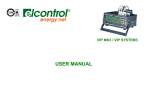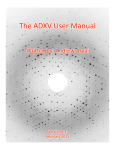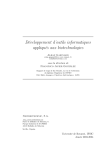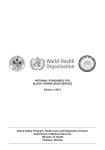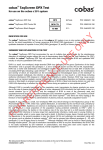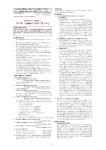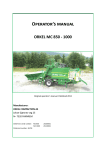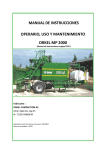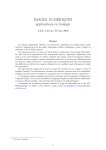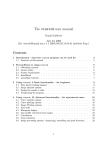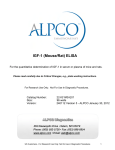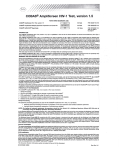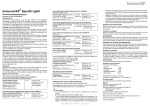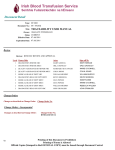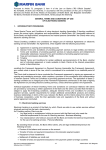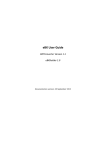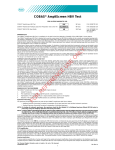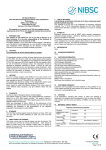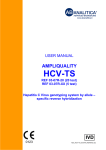Download cobas TaqScreen WNV Test kit
Transcript
cobas® TaqScreen West Nile Virus Test for use on the cobas s 201 system FOR IN VITRO DIAGNOSTIC USE. cobas® TaqScreen West Nile Virus Test ® cobas TaqScreen West Nile Virus Control Kit cobas® TaqScreen Wash Reagent WNV 96 Tests P/N: 04741722 190 WNV CTL 6 Sets P/N: 04741749 190 TS WR 5.1 L P/N: 04404220 190 For testing cadaveric specimens with the cobas® TaqScreen West Nile Virus Test, the following kit is required by the user, in addition to the kits above: cobas® TaqScreen Cadaveric Specimen Diluent Kit CADV SPEC DIL 96 Tests P/N: 05002125 190 TABLE OF CONTENTS TABLE OF CONTENTS.................................................................................................................................................................. 1 List of Tables .............................................................................................................................................................................. 2 INTENDED USE .............................................................................................................................................................................. 3 SUMMARY AND EXPLANATION OF THE TEST .................................................................................................................. 3 PRINCIPLES OF THE PROCEDURE .......................................................................................................................................... 3 Automated Specimen Pooling and Pipetting using the Hamilton MICROLAB STAR/STARlet IVD Pipettor ........................................................................................................ 3 Automated Specimen Preparation using the COBAS® AmpliPrep Instrument .................................................... 4 Automated Amplification of Nucleic Acid using the COBAS® TaqMan® Analyzer ............................................ 4 Reverse Transcription and PCR Amplification ........................................................................................................... 4 Selective Amplification...................................................................................................................................................... 4 Real time Automated Detection of PCR Products using the COBAS® TaqMan® Analyzer ............................. 4 Detection of PCR Products ............................................................................................................................................. 5 Automated Data Management using the PDM Software ........................................................................................... 5 MATERIALS PROVIDED BY ROCHE........................................................................................................................................ 5 OTHER MATERIALS REQUIRED BUT SOLD SEPARATELY (MAY BE PURCHASED FROM ROCHE) ................................................................................................................................ 6 Instrumentation and Software for cobas s 201 system – Configuration C or Configuration C Maintenance Release 1 (MR1) ....................................................................... 6 Racks and Disposables........................................................................................................................................................... 6 REAGENTS ....................................................................................................................................................................................... 7 STORAGE AND HANDLING REQUIREMENTS .................................................................................................................... 9 PRECAUTIONS ............................................................................................................................................................................. 10 REAGENT PREPARATION ......................................................................................................................................................... 11 SPECIMEN COLLECTION, STORAGE AND POOLING..................................................................................................... 11 Living Donor Specimens ...................................................................................................................................................... 11 Cadaveric Specimens ........................................................................................................................................................... 12 SPECIMEN POOLING AND PIPETTING ................................................................................................................................ 13 PROCEDURAL NOTES ............................................................................................................................................................... 13 INSTRUCTIONS FOR USE ......................................................................................................................................................... 14 The Document Revision Information section is located at the end of this document. 05618169001-04EN 1 Doc Rev. 4.0 QUALITY CONTROL .................................................................................................................................................................... 17 RESULTS ......................................................................................................................................................................................... 17 Repeat Needed ....................................................................................................................................................................... 17 Pool Testing - Resolution Needed .................................................................................................................................... 17 PROCEDURAL LIMITATIONS .................................................................................................................................................. 18 PERFORMANCE CHARACTERISTICS ................................................................................................................................... 18 LIVING DONOR SPECIMENS................................................................................................................................................... 18 Reproducibility......................................................................................................................................................................... 18 Analytical Sensitivity - Health Canada Standard - Lineage 1 ................................................................................... 20 Analytical Sensitivity - Roche WNV Secondary Standard - Lineage 1................................................................... 20 Analytical Sensitivity - CBER/FDA West Nile Virus Panel - Lineage 1 .................................................................. 21 Analytical Sensitivity - West Nile Virus RNA Qualification Panel QWN701 - Lineage 2 .................................. 21 Analytical Specificity - Potentially Cross Reactive and Interfering Microorganisms ......................................... 22 Analytical Specificity - Other Disease States ................................................................................................................ 22 Potentially Interfering Substances ..................................................................................................................................... 22 Endogenous Interfering Substances ........................................................................................................................... 22 Exogenous Interfering Substances .............................................................................................................................. 23 CADAVERIC DONOR SPECIMENS ........................................................................................................................................ 23 Reproducibility......................................................................................................................................................................... 23 Specificity.................................................................................................................................................................................. 24 Analytical Sensitivity in Cadaveric Specimens with Roche WNV Secondary Standard .................................... 24 Sensitivity .................................................................................................................................................................................. 25 CLINICAL PERFORMANCE- LIVING DONOR SPECIMENS ........................................................................................... 26 Clinical Sensitivity - Testing of Known West Nile Virus Positive Specimens ........................................................ 26 Clinical Specificity .................................................................................................................................................................. 26 Pooled Testing Results ......................................................................................................................................................... 26 Individual Testing Results..................................................................................................................................................... 27 REFERENCES ................................................................................................................................................................................ 28 List of Tables Table 1: cobas® TaqScreen West Nile Virus Test - Reproducibility Results ............................................................ 19 Table 2: Analytical Sensitivity Summary with the Health Canada West Nile Virus Standard ................................ 20 Table 3: Analytical Sensitivity Summary with the Roche WNV Secondary Standard .............................................. 20 Table 4: Analytical Sensitivity Summary with the CBER/FDA West Nile Virus Panel ............................................. 21 Table 5: Analytical Sensitivity Summary with the West Nile Virus RNA Qualification Panel QWN701 - Lineage 2 ............................................................................................................. 21 Table 6: Microorganisms Tested ............................................................................................................................................. 22 Table 7: Reproducibility Summary of Cadaveric Specimens and Living Donor Specimens Results by Kit Lot ........................................................................................................................................................ 23 Table 8: Reproducibility Summary of Cadaveric Specimens and Living Donor Specimens Results by Operator - Instrument Pair .................................................................................................................. 23 Table 9: Summary of Testing with the cobas® TaqScreen WNV Test for Specificity of Cadaveric and Living Donor Specimens ........................................................................................................................................... 24 Table 10: Analytical Sensitivity Summary with the Roche WNV Secondary Standard in Moderately Hemolyzed Cadaveric Specimens .................................................................................................. 25 Table 11: Analytical Sensitivity Summary with the Roche WNV Secondary Standard in Highly Hemolyzed Sample Matrix .......................................................................................................................... 25 05618169001-04EN 2 Doc Rev. 4.0 Table 12: Summary of Sensitivity for WNV with Moderately Hemolyzed (MH) and Highly Hemolyzed (HH) Cadaveric Specimens ................................................................................................. 26 Table 13: Clinical Sensitivity of Known West Nile Virus Positive Specimens ............................................................. 26 Table 14: Clinical Specificity of the cobas® TaqScreen West Nile Virus Test - Pooled Testing ......................... 27 Table 15: Clinical Specificity of the cobas® TaqScreen West Nile Virus Test - Individual Testing .................... 27 INTENDED USE The cobas® TaqScreen West Nile Virus Test, for use with the cobas s 201 system, is a qualitative in vitro test for the direct detection of West Nile Virus (WNV) RNA in human plasma. This test is intended as a donor screening test to detect WNV RNA in plasma specimens from individual human donors, including donors of whole blood and blood components and other living donors. This test is also intended for use in testing plasma specimens to screen individual organ donors when specimens are obtained while the donor's heart is still beating and in testing blood specimens from cadaveric (non-heartbeating) donors. This test is not intended for use on samples of cord blood. Plasma from all donors may be screened as individual specimens. For donations of whole blood and blood components, plasma specimens may be tested in pools comprised of not more than six equal aliquots of individual specimens. For donations from cadaveric (non-heart-beating) organ and tissue donors, plasma and serum specimens may only be screened as individual specimens. This test is not intended for use as an aid in diagnosis. SUMMARY AND EXPLANATION OF THE TEST West Nile Virus is a member of the Flaviviridiae family, the genus Flavivirus and the Japanese encephalitis virus serocomplex. Viruses in this complex are arboviruses with the potential to cause meningitis, encephalitis and meningoencephalitis. Other members of the Japanese encephalitis group include Japanese encephalitis virus, Murray Valley encephalitis virus, Kunjin (now known to be a variant of WNV) and St. Louis encephalitis virus; the latter caused an epidemic of encephalitis in the US in the mid-1970s1,2. The cobas® TaqScreen West Nile Virus Test is a qualitative test that enables the screening and detection of WNV RNA in infected pooled and individual specimen donations. The cobas® TaqScreen West Nile Virus Test uses a generic nucleic acid preparation technique on the COBAS® AmpliPrep Instrument. WNV RNA is then detected by automated, real time PCR amplification on the COBAS® TaqMan® Analyzer. The test incorporates an Internal Control for monitoring test performance in each individual test as well as the AmpErase enzyme to reduce potential contamination by previously amplified material (amplicon). PRINCIPLES OF THE PROCEDURE The cobas® TaqScreen West Nile Virus Test used on the cobas s 201 system is based on 4 major processes: 1. Automated Specimen Pooling and Control Pipetting using the Hamilton MICROLAB® STAR/STARlet IVD Pipettor 2. Automated Specimen Preparation using the COBAS® AmpliPrep Instrument 3. Automated Amplification of Nucleic Acid and Real Time Automated Detection of PCR products using the COBAS® TaqMan® Analyzer 4. Automated Data Management using the Pooling and Data Management (PDM) Software Automated Specimen Pooling and Pipetting using the Hamilton MICROLAB STAR/STARlet IVD Pipettor The Hamilton MICROLAB STAR/STARlet IVD Pipettor automates pipetting of pools and individual donor specimens, transfer of aliquots to Deep Well Plates (optional) and pipetting of Test Controls. The cobas s 201 system is used for resolution testing of reactive pools and to identify the reactive individual specimens. The cobas s 201 system is designed to process specimens in batches. A batch is defined as a collection of specimens and controls that are pipetted, extracted, amplified and detected together. When the pipetting of a batch is completed on the Hamilton MICROLAB STAR/STARlet IVD Pipettor, the entire sample rack is transferred into the COBAS® AmpliPrep Instrument for the next phase of the process. 05618169001-04EN 3 Doc Rev. 4.0 Note: For testing of cadaveric specimens, the specimen should first be manually diluted 1:5 in cobas® TaqScreen Cadaveric Specimen Diluent (CADV SPEC DIL) prior to pipetting using the Hamilton MICROLAB STAR/STARlet IVD Pipettor. Automated Specimen Preparation using the COBAS® AmpliPrep Instrument Nucleic acids from the targets and added Armored RNA Internal Control (IC) molecules (which serves as a specimen preparation and amplification/detection process control) are simultaneously processed. The cobas® TaqScreen West Nile Virus Test contains reagents that accomplish five sequential steps on the COBAS® AmpliPrep Instrument. The Protease solution digests proteins to promote lysis, inactivate nucleases and facilitate the release of RNA and DNA from viral particles. Addition of Lysis Reagent to the specimen results in viral lysis and nuclease inactivation by denaturation of proteins. RNA and DNA are released and simultaneously protected from nucleases. The released nucleic acids bind to the silica surface of the added Magnetic Glass Particles. This is mainly due to the net positive charge on the glass particle surface and net negative charge of the nucleic acids under the chaotropic salt concentration and ionic strength of the Lysis reaction. Wash Reagent removes unbound substances and impurities such as denatured proteins, cellular debris and potential PCR inhibitors (such as hemoglobin, etc.), and reduces the salt concentration. Purified nucleic acids are released from the Magnetic Glass Particles at an elevated temperature with Elution Buffer. Automated Amplification of Nucleic Acid using the COBAS® TaqMan® Analyzer After isolation of the purified nucleic acids during automated specimen preparation, the cobas® TaqScreen WNV Master Mix (WNV MMX) is used for the amplification and detection of WNV RNA and IC RNA. Once activated by the addition of manganese acetate, the WNV MMX permits reverse transcription, followed by PCR amplification of a highly conserved region of WNV RNA and IC RNA using specific primers. Concurrent detection of the amplified DNA is accomplished by the generation of fluorescent signals from 5'-nucleolytic degradation of WNV and IC-specific probes, also present in the WNV MMX. Two fluorescent dyes are used: one dye labels the IC probe and a second dye labels the target specific probe permitting independent identification of WNV and IC. Reverse Transcription and PCR Amplification Reverse transcription and amplification reactions are performed with a thermostable recombinant enzyme, Z05 DNA Polymerase. In the presence of manganese (Mn2+), Z05 DNA Polymerase has reverse transcriptase and DNA polymerase activities. This allows both reverse transcription and PCR amplification to occur in the same reaction mixture. PCR amplification is accomplished using the Z05 DNA Polymerase which extends the annealed primers along the target templates to produce a double-stranded DNA (amplicon). This process is repeated for multiple cycles, with each cycle doubling the amount of amplicon DNA. Amplification occurs only in the region of the target genomes between the primers; the entire genomes are not amplified. Selective Amplification Selective amplification of target nucleic acid from the specimen is achieved in the cobas® TaqScreen West Nile Virus Test by the use of AmpErase (uracil-N-glycosylase) enzyme and deoxyuridine triphosphate (dUTP). The AmpErase enzyme recognizes and catalyzes the destruction of DNA strands containing deoxyuridine3, but not DNA containing deoxythymidine or RNA containing ribouridine4, 5. Deoxyuridine is not present in naturally occurring DNA, but is always present in amplicon because of the use of deoxyuridine triphosphate with thymidine triphosphate as one of the dNTPs in the WNV MMX reagent; therefore, only amplicon contains deoxyuridine. Deoxyuridine renders contaminating amplicon susceptible to destruction by the AmpErase enzyme prior to amplification of the target RNA. Also, any nonspecific product formed after initial activation of the WNV MMX by manganese is destroyed by the AmpErase enzyme. The AmpErase enzyme, which is included in the WNV MMX reagent, catalyzes the cleavage of deoxyuridine-containing DNA at the deoxyuridine residues by opening the deoxyribose chain at the C1-position. When heated in the first thermal cycling step, the amplicon DNA chain breaks at the position of the deoxyuridine, thereby rendering the DNA non-amplifiable. The AmpErase enzyme remains inactive for a prolonged period of time once exposed to temperatures above 55ºC and therefore does not destroy target amplicon formed after PCR. Real time Automated Detection of PCR Products using the COBAS® TaqMan® Analyzer During PCR Amplification, the intermittent high temperature during the cycling denatures the Target and IC amplicon to form single stranded DNA. The specific detection oligonucleotide probes hybridize to the single stranded form of the amplified DNA. Amplification, Hybridization and Detection occur simultaneously. 05618169001-04EN 4 Doc Rev. 4.0 Detection of PCR Products The cobas® TaqScreen WNV MMX contains detection probes which are specific for WNV or IC nucleic acid. Each detection probe is labeled with two fluorescent dyes, one acting as a reporter dye and the other as a quencher dye. One type of reporter dye is associated with the target specific probe and is measured at a defined wavelength. A second reporter dye is associated with the IC specific probe and is measured at a different wavelength. A single type of quencher dye is used in both probes. This system permits detection of the amplified WNV target at one wavelength and simultaneous detection of amplified IC nucleic acid at another wavelength. Before PCR amplification begins, the probes are intact and the reporter dye fluorescence is suppressed by the quencher dye due to Förster-type energy transfer. During PCR amplification, the probes hybridize to specific single stranded DNA sequences and are cleaved by the 5' to 3' nuclease activity of the Z05 DNA Polymerase at the same time that amplification is occurring. Once the reporter and quencher dyes are separated by this cleavage, the fluorescent activity of the reporter dye is unmasked. With each PCR cycle, increasing amounts of cleaved probes are generated and the cumulative signal of the reporter dye is concomitantly increased. Real time detection of PCR products is accomplished by measuring the fluorescence of the released reporter dyes representing WNV target and IC independently.6, 7 Automated Data Management using the PDM Software Roche PDM Data Manager allows the user to review and report results. The Roche PDM Data Manager assigns test results for all tests as non-reactive, reactive or invalid. In addition to retrieving and examining PCR results, the Roche PDM software allows the operator to print reports, search for results, accept donor results and optionally transmit results to an LIS. MATERIALS PROVIDED BY ROCHE Three kits are required and provided for the detection of WNV RNA in plasma specimens: (1) cobas® TaqScreen West Nile Virus Test, (2) cobas® TaqScreen West Nile Virus Control Kit, and (3) cobas® TaqScreen Wash Reagent. Safety Data Sheets (SDS) are available on request from your local Roche office. cobas® TaqScreen West Nile Virus Test (P/N: 04741722 190) WNV 96 Tests WNV CS1 (WNV Magnetic Glass Particles Reagent Cassette) WNV CS2 (WNV Lysis Reagent Cassette) WNV CS3 (WNV Multi-Reagent Cassette) WNV CS4 (WNV Test-Specific Reagent Cassette) cobas® TaqScreen West Nile Virus Control Kit (P/N: 04741749 190) WNV CTL 6 Sets WNV (+) C (WNV Positive Control) WNV (–) C [WNV Negative Control (Human Plasma)] cobas® TaqScreen Wash Reagent (P/N: 04404220 190) TS WR 5.1 L TS WR (cobas® TaqScreen Wash Reagent) Note: For detection of WNV RNA in cadaveric specimens, the following kit is required and provided, in addition to the kits above: cobas® TaqScreen Cadaveric Specimen Diluent Kit. 05618169001-04EN 5 Doc Rev. 4.0 cobas® TaqScreen Cadaveric Specimen Diluent Kit (P/N: 05002125 190) 96 Tests CADV SPEC DIL CADV SPEC DIL (cobas® TaqScreen Cadaveric Specimen Diluent) OTHER MATERIALS REQUIRED BUT SOLD SEPARATELY (MAY BE PURCHASED FROM ROCHE) This test must be run on the cobas s 201 system. The cobas s 201 system must be installed by a Roche Diagnostics Field Service Representative, and used as a complete system configuration. Individual cobas s 201 system components cannot be used as stand-alone devices, nor may other components be substituted. The cobas s 201 system utilizes the components listed below. Please refer to the Product Information Card for additional details. Instrumentation and Software for cobas s 201 system - Configuration C or Configuration C Maintenance Release 1 (MR1) • Hamilton MICROLAB STAR and/or STARlet IVD Pipettor • COBAS® AmpliPrep Instrument • COBAS® TaqMan® Analyzer (with EX48 upgrade) • AMPLILINK software datastation and software v3.1.2 or v3.2.1 • Roche PDM Data Manager Server, Data Manager workstation and software v2.0.10 or v2.0.14 • cobas s 201 Configuration C or Configuration C (MR1) system Operator's Manual • cobas s 201 system - Configuration C or Configuration C (MR1), Known Issues List Racks and Disposables • COBAS® AmpliPrep Sample Racks (SK24) (P/N: 28122172001) • COBAS® AmpliPrep SPU-racks (P/N: 05471664001) • COBAS® AmpliPrep Reagent Racks (P/N: 28122199001) • Sample Processing Units (SPU): (P/N: 03755525001) • Sample Input Tubes (S-tubes) with Barcode Clips (P/N: 03137040001) • Racks of K-tips (P/N: 03287343001) • K-tube Box of 12 x 96 (P/N: 03137082001) • COBAS® TaqMan® K-carrier (P/N: 28150397001) • High Volume CO-RE Tips (1000 μL), filter (P/N: 04639642001) • Deep Well Plates with Barcode Labels (P/N: 04639634001) • Deep Well Plate Sealing Mats (P/N: 04789288001) • Sample Carrier for 24 Test Tubes (P/N: 04639502001) • Sample Carrier for 32 Test Tubes (P/N: 04639529001) • Tip Carrier (P/N: 04639545001) • Deep Well Plate Carrier (P/N: 04639553001) • SK24 Rack Carrier (P/N: 04639600001) • Microcide SQTM or HAMILTON Disinfectant Spray (P/N: 04592557001) • Disposable gloves, powderless 05618169001-04EN 6 Doc Rev. 4.0 REAGENTS cobas® TaqScreen West Nile Virus Test (P/N: 04741722 190) WNV WNV CS1 MGP (Magnetic Glass Particles) Magnetic glass particles 93% Isopropanol Xi 96 Tests 2 x 48 Tests 2 x 7.0 mL 93% (w/w) Isopropanol Irritant F 93% (w/w) Isopropanol Highly Flammable WNV CS2 LYS (Lysis Reagent) Sodium citrate dihydrate 42.5% Guanidine thiocyanate < 14% Polydocanol 0.9% Dithiothreitol Xn 2 x 48 Tests 2 x 78 mL 42.5% (w/w) Guanidine thiocyanate Harmful WNV CS3 Pase (Proteinase Solution) TRIS buffer < 0.05% EDTA Calcium chloride Calcium acetate - 7.8% Proteinase Glycerol Xn 2 x 48 Tests 2 x 3.8 mL - 7.8% (w/w) Proteinase Harmful WNV EB (WNV Elution Buffer) TRIS buffer ≤ 0.002% Poly rA RNA (synthetic) EDTA 0.09% Sodium azide 05618169001-04EN 2 x 7.0 mL 7 Doc Rev. 4.0 WNV CS4 WNV MMX (WNV Master Mix) Tricine buffer Potassium acetate Glycerol < 18% Dimethylsulfoxide < 0.07% dATP, dCTP, dGTP, dUTP < 0.002% Upstream and downstream WNV primers < 0.002% Fluorescent-labeled WNV probe < 0.002% Fluorescent-labeled Internal Control probe < 0.002% Oligonucleotide aptamer < 0.05% Z05 DNA Polymerase (microbial) < 0.1% AmpErase (uracil-N-glycosylase) enzyme (microbial) 0.08% Sodium azide 2 x 48 Tests 2 x 2.5 mL WNV Mn2+ (WNV Manganese Solution) < 0.6% Manganese acetate Glacial acetic acid 0.09% Sodium azide 2 x 19.8 mL WNV IC (WNV Internal Control) TRIS buffer ≤ 0.002% Poly rA RNA (synthetic) EDTA 0.05% Sodium azide < 0.001% Non-infectious, synthetic internal control RNA encapsulated in MS2 bacteriophage coat protein cobas® TaqScreen West Nile Virus Control Kit (P/N: 04741749 190) 2 x 3.6 mL WNV CTL WNV (+) C (WNV Positive Control) TRIS buffer ≤ 0.002% Poly rA RNA (synthetic) EDTA 0.05% Sodium azide < 0.001% Non-infectious, synthetic WNV RNA encapsulated in MS2 bacteriophage coat protein 05618169001-04EN 8 6 Sets 6 x 1.1 mL Doc Rev. 4.0 WNV (–) C [WNV Negative Control (Human Plasma)] Negative Human Plasma, non-reactive by licensed tests for antibody to HCV, antibody to HIV-1/2 and HBsAg; WNV RNA not detectable by PCR methods 0.1% ProClin® 300 preservative Xi 12 x 1.6 mL (3:1) mixture of 5-Chloro-2-methyl-2H-isothiazol-3-one and 2-Methyl-2H-isothiazol-3-one Irritant R36/38: Irritating to eyes and skin R43: May cause sensitization by skin contact cobas® TaqScreen Wash Reagent (P/N: 04404220 190) TS WR 5.1 L TS WR (cobas® TaqScreen Wash Reagent) Sodium citrate dihydrate 0.1% Methylparaben preservative cobas® TaqScreen Cadaveric Specimen Diluent Kit (P/N: 05002125 190) CADV SPEC DIL (cobas® TaqScreen Cadaveric Specimen Diluent) EDTA CADV SPEC DIL 96 Tests 4 x 100 mL STORAGE AND HANDLING REQUIREMENTS A. Room temperature is defined as 15 to 30°C. B. Do not freeze reagents or controls. C. Store WNV CS1, WNV CS2, WNV CS3 and WNV CS4 at 2 to 8°C. Unused, these reagents are stable until the expiration date indicated. D. After initial use, reagents are stable for 30 days at 2 to 8°C or until the expiration date, whichever comes first. E. Reagents can be used for up to 6 instrument runs, for up to a maximum of 40 cumulative hours on the COBAS® AmpliPrep Instrument. Reagents must be stored at 2 to 8°C between uses. The AMPLILINK software monitors the cumulative hours of the reagent cassettes in the COBAS® AmpliPrep Instrument, and blocks the cassettes from being used once the 40 cumulative hours are reached. F. Reagents are stable for a total of 24 continuous hours on the COBAS® AmpliPrep Instrument. The AMPLILINK software does not monitor the continuous hours of the reagent cassettes in the instrument, nor the number of instrument runs the cassettes have been used for. It is the user’s responsibility to discard the reagent cassettes once the 24 continuous hours or 6 instrument runs are reached G. Store WNV (+) C and WNV (–) C at 2 to 8°C. The controls are stable until the expiration date indicated. Once opened, any unused portion must be discarded. H. Store TS WR at 15 to 30°C. Unopened TS WR is stable until the expiration date indicated. Once opened, this reagent is stable for 30 days at 15 to 30°C or until the expiration date, whichever comes first. I. Store CADV SPEC DIL at 15 to 30°C. The diluent is stable until the expiration date indicated. Once opened, any unused diluent remaining in the container must be discarded. 05618169001-04EN 9 Doc Rev. 4.0 PRECAUTIONS FOR IN VITRO DIAGNOSTIC USE. A. Specimens may be infectious. Use Universal Precautions when performing the test8, 9. Only personnel proficient in the use of the cobas® TaqScreen West Nile Virus Test and trained in handling infectious materials should perform this procedure. Thoroughly clean and disinfect all laboratory work surfaces with a freshly prepared solution of 0.5% sodium hypochlorite in distilled or deionized water. Follow by wiping the surface with 70% Ethanol. B. CAUTION: WNV (–) C contains Human Plasma derived from human blood. The source material has been tested and found non-reactive for the presence of antibody to HIV-1/2, antibody to HCV, and HBsAg. Testing of Negative Human Plasma by PCR methods showed no detectable WNV RNA. No known test method can offer complete assurance that products derived from human blood will not transmit infectious agents. All human blood-sourced materials should be considered potentially infectious and should be handled with Universal Precautions. If spillage occurs, immediately disinfect with a freshly prepared solution of 0.5% sodium hypochlorite (dilute bleach) or follow appropriate site procedures. C. Use routine laboratory precautions. Do not pipette by mouth. Do not eat, drink or smoke in designated work areas. Wear disposable gloves, laboratory coats and eye protection when handling specimens and kit reagents. Wash hands thoroughly after handling specimens and kit reagents. D. WNV EB, WNV MMX, WNV Mn2+, WNV IC and WNV (+) C contain sodium azide as a preservative. Do not use metal tubing for reagent transfer. If solutions containing azide are disposed of in a plumbing system, they should be diluted and flushed with generous amounts of running water. These precautions are recommended to avoid accumulation of deposits in metal piping in which explosive conditions could develop. E. Heparin has been shown to inhibit PCR. Do not use heparinized plasma with this procedure. F. The use of sterile disposable pipettes and nuclease-free pipette tips is recommended. False positive results may occur if cross contamination of specimens is not prevented during specimen handling and processing. G. Use only supplied or specified required disposables to ensure optimal test performance. H. Handle all materials containing specimens or controls according to Good Laboratory Practices in order to prevent cross-contamination of specimens or controls. I. Before use, visually inspect each reagent cassette, control tube and Wash Reagent to ensure that there are no signs of leakage. If there is any evidence of leakage, do not use that material for testing. J. Dispose of all materials that have come in contact with specimens and reagents in accordance with country, federal, state and local regulations. K. Do not use a cobas® TaqScreen West Nile Virus Test, cobas® TaqScreen West Nile Virus Control Kit, cobas® TaqScreen Wash Reagent or cobas® TaqScreen Cadaveric Specimen Diluent Kit after its expiration date. Do not interchange, mix, or combine reagents from different kits or different lots. Do not load mixed reagent lots on the COBAS® AmpliPrep Instrument. L. Safety Data Sheets (SDS) are available on request from your local Roche office. M. Avoid contact of reagents with the skin, eyes or mucous membranes. If contact does occur, immediately wash with large amounts of water, otherwise, burns can occur. If these reagents are spilled, dilute with water before wiping dry. Do not allow LYS, which contains guanidine thiocyanate, to contact sodium hypochlorite (bleach) solution. This mixture can produce a highly toxic gas. N. Closely follow procedures and guidelines provided to ensure that the test is performed correctly. Any deviation from the procedures and guidelines may affect optimal test performance. O. The use of excessively hemolyzed living donor specimens should be avoided. P. Red blood cell contamination of plasma specimens (> 5%) may inhibit the cobas® TaqScreen West Nile Virus Test. Q. Do not use any component with damaged barcode labels at any phase of testing. R. When testing specimens from cadaveric donors, specimens displaying a straw to pink color are classified as Moderately Hemolyzed and specimens displaying a red to dark-red or brown color are classified as Highly Hemolyzed specimens. 05618169001-04EN 10 Doc Rev. 4.0 REAGENT PREPARATION A. Equilibrate cobas® TaqScreen WNV reagents and controls to room temperature for 30 minutes before using. SPECIMEN COLLECTION, STORAGE AND POOLING Note: Handle all specimens as if they are infectious agents. Living Donor Specimens A. Plasma specimens collected using EDTA, CPD, CPDA1, CP2D, ACDA and 4% Sodium Citrate may be used with the cobas® TaqScreen West Nile Virus Test. Follow the sample tube manufacturer instructions. Specimen stability is affected by elevated temperatures. B. Blood collected in K2 EDTA and K3 EDTA anticoagulants may be stored in one of two conditions. For Condition 1, blood may be stored for up to 24 hours at 2-30°C, followed by 24 hours at 2-25°C, followed by 72 hours at 2-8°C, prior to plasma separation. For storage longer than five days, separate the plasma from the red blood cells by centrifugation at 800 - 1,600 x g for 20 minutes. Following removal, plasma may be stored at 2-8ºC for seven days, followed by up to 30 days at ≤ -20°C. EDTA Anticoagulant – Condition 1 30°C Temperature (°C) 30 25°C 20 2-8°C 10 Whole Blood Plasma 0 0 1 2 3 4 5 6 7 8 9 10 11 12 13 14 15 Days Post Collection For Condition 2, blood may be stored for up to 72 hours at 2-25°C, followed by 48 hours at 2-8°C, prior to plasma separation. For storage longer than five days, separate the plasma from the red blood cells by centrifugation at 800 - 1,600 x g for 20 minutes. Following removal, plasma may be stored at 2-8ºC for seven days, followed by up to 30 days at ≤ -20°C. K2 EDTA and K3 EDTA plasma can be frozen and thawed a maximum of three (3) times EDTA Anticoagulant – Condition 2 Temperature (°C) 30 25°C 20 2-8°C 10 Whole Blood Plasma 0 0 1 2 3 4 5 6 7 8 9 10 11 12 13 14 15 Days Post Collection C. Blood collected in CPD, CPDA1 and CP2D anticoagulants may be stored for up to 24 hours at 2-30°C, prior to plasma separation. For storage longer than one day, separate the plasma from the red blood cells by centrifugation at 800 - 1,600 x g for 20 minutes. Following removal, plasma may be stored at 2-8ºC for seven days, followed by up to 30 days at ≤ -20°C. For long-term storage, plasma separated from red blood cells may be stored at ≤ -70ºC for up to 30 months. CPD, CPDA1 and CP2D plasma can be frozen and thawed a maximum of three (3) times. 05618169001-04EN 11 Doc Rev. 4.0 CPD, CPDA1, CP2D Anticoa gula nt 30˚C 30°C Te mpe ra ture ( C) 30 20 2- 8°C 10 Whole Whole Blood Blood Pla s ma 0 0 1 2 3 4 5 6 7 8 Da ys Pos t Colle ction D. Apheresis plasma in ACDA or 4% Sodium Citrate anticoagulants may be stored for up to 24 hours at 2-30°C from time of draw. Apheresis plasma may be stored for up to 30 days at ≤ -20ºC. Apheresis plasma in ACDA or 4% Sodium Citrate can be frozen and thawed a maximum of three (3) times. E. The following plasma volume guidelines are based on pipetting from 13 x 100 mm glass or plastic donor tubes on the Hamilton MICROLAB STAR/STARlet IVD Pipettor. The listed volumes are for plasma on top of packed red blood cells, and are for use when running the cobas® TaqScreen West Nile Virus Test. Pool Type Primary Pool of 6 * Primary Pool of 1 * Repeat Pool From Tube Resolution Pool from Tube *Includes creation of Deep Well Plate F. Minimum Plasma Volume 3 mL 3 mL 1.5 mL 2 mL Do not freeze whole blood. G. Heparin has been shown to inhibit PCR. Use of heparinized specimens is not recommended. H. Covered Deep Well Plates may be stored at 2 to 8°C for up to seven days from the date the plasma was removed from the red blood cells. Alternatively, covered Deep Well Plates may be stored at ≤ -18ºC for longer periods. I. No adverse effect on test performance was observed when plasma specimens were subjected to three (3) freeze/thaw cycles. J. Equilibrate pooled or individual donor specimens to room temperature before using. K. If specimens are to be shipped, they should be packaged and labeled in compliance with applicable federal and international regulations covering the transport of specimens and etiologic agents10. L. False positive results may occur if cross contamination of specimens is not adequately controlled during specimen handling and processing. Cadaveric Specimens A. Cadaveric blood specimens collected in EDTA anticoagulant tubes or in serum tubes may be used with the cobas® TaqScreen West Nile Virus Test. Follow the sample tube manufacturer instructions. Specimen stability is affected by elevated temperatures. B. Cadaveric blood collected in EDTA anticoagulant may be stored for up to 24 hours at 2-25ºC, prior to plasma separation. For storage longer than one day, separate the plasma from the red blood cells by centrifugation at 800 - 1,600 x g for 20 minutes. Following removal, plasma may be stored at 2-8ºC for an additional seven days. Alternatively, plasma may be stored at ≤ -18ºC for up to 30 days. Cadaveric EDTA plasma can be frozen and thawed a maximum of three (3) times. 05618169001-04EN 12 Doc Rev. 4.0 C. Cadaveric blood collected as serum may be stored for up to 24 hours at 2-8ºC, prior to separation. For storage longer than one day, separate the serum from the clot by centrifugation at 800 – 1,600 x g for 20 minutes. Following removal, serum specimens may be stored for up to three days at 2-8ºC. Alternatively, in the case of serum removed from the clot, Moderately Hemolyzed cadaveric serum specimens may be stored at ≤ -18ºC for up to 15 days and Highly Hemolyzed cadaveric serum specimens may be stored at ≤ -18°C for up to 8 days. Cadaveric serum specimens can be frozen and thawed a maximum of three (3) times. D. Cadaveric specimens diluted 1:5 in the cobas® TaqScreen Cadaveric Specimen Diluent may be stored for up to 7 days at 2-8ºC and after remixing (by pipetting up and down four (4) times in each tube), may be tested with the cobas® TaqScreen West Nile Virus Test. E. If specimens are to be shipped, they should be packaged and labeled in compliance with applicable federal and international regulations covering the transport of specimens and etiologic agents. 10 F. False-positive results may occur if cross contamination of specimens is not adequately controlled during specimen handling and processing. SPECIMEN POOLING AND PIPETTING 1. The cobas s 201 system utilizes the Hamilton MICROLAB STAR/STARlet IVD Pipettor for all pipetting and pooling activities. The Hamilton MICROLAB STAR/STARlet IVD Pipettor performs barcode scanning and pooling operations from equal aliquots of specimen volume to form pools. 2. If reactive pools are detected by the cobas® TaqScreen West Nile Virus Test, the Hamilton MICROLAB STAR/STARlet IVD Pipettor is used to pipette the individual specimens from either Deep Well Plates or original specimen tubes for Resolution Testing. PROCEDURAL NOTES A. Equipment 1. Prepare the cobas s 201 system for use according to instructions in the cobas s 201 system Operator's Manual. 2. Perform recommended maintenance on instruments to ensure proper functioning. B. Reagents 1. The cobas® TaqScreen West Nile Virus Test reagents, cobas® TaqScreen West Nile Virus Control Kit and cobas® TaqScreen Wash Reagent must be equilibrated for 30 minutes at room temperature before use. See Storage and Handling Requirements Section for reagent storage conditions. 2. Each cobas® TaqScreen West Nile Virus Test kit contains sufficient material for processing a total of 96 tests which are recommended to be run in batches consisting of up to 24 tests per SK24 rack. One replicate of the Negative Control [WNV (–) C] and one replicate of the Positive Control [WNV (+) C] must be processed with each batch or SK24 rack. 3. Each cobas® TaqScreen Cadaveric Specimen Diluent Kit contains sufficient material for processing a total of 96 tests which are recommended to be run in batches consisting of up to 24 tests per SK24 rack. One replicate of the Negative Control [WNV (–) C] and one replicate of the Positive Control [WNV (+) C] must be processed with each batch or SK24 rack. Controls are processed in the same way when testing living donor and cadaveric specimens with the cobas® TaqScreen West Nile Virus Test. 4. All controls are for single use only. 5. The system will prevent the use of reagents which have exceeded the allowed hours on the COBAS® AmpliPrep Instrument (more than 40 cumulative hours and 30 days after initial use), reagents which have expired or mixed cassettes from a set of four cassettes previously used on the system. C. Specimen Processing 1. Avoid contaminating gloves when handling specimens and controls. 2. Care should be used to avoid contamination of specimens and [WNV (–) C] with Positive Controls. 05618169001-04EN 13 Doc Rev. 4.0 INSTRUCTIONS FOR USE The cobas s 201 system includes four major processes: Specimen and Control Pipetting on the Hamilton MICROLAB STAR/STARlet IVD Pipettor, Specimen preparation on the COBAS® AmpliPrep Instrument using the cobas® TaqScreen West Nile Virus Test, Amplification/Detection on the COBAS® TaqMan® Analyzer and Data Management. The cobas s 201 system configuration allows up to six Hamilton MICROLAB STAR/STARlet IVD Pipettors, five Data Manager Workstations and ten AMPLILINK datastations. Each AMPLILINK datastation allows up to three COBAS® AmpliPrep Instruments and two COBAS® TaqMan® Analyzers. Refer to the cobas s 201 system Operator's Manual for detailed information regarding the cobas s 201 system configuration. Each cobas® TaqScreen West Nile Virus Test kit contains eight cassettes: two WNV CS1 cassettes with Magnetic Glass Particles, two WNV CS2 cassettes with Lysis Reagent, two WNV CS3 cassettes with Protease and Elution Buffer, and two WNV CS4 cassettes with IC, MMX Reagent and Manganese Solution. This test kit is to be used in conjunction with the cobas® TaqScreen West Nile Virus Control Kit and the cobas® TaqScreen Wash Reagent and for processing cadaveric specimens with the cobas® TaqScreen Cadaveric Specimen Diluent Kit. Note: Do not open the cassettes. Note: Do not pool reagents from different lots or from different bottles of the same lot. Note: Do not mix reagents (including cassettes) from different kits. Do not load mixed reagent lots on the COBAS® AmpliPrep Instrument. Note: Do not separate control tubes from adapters (the plastic control tube holder). Note: The PDM Software tracks and enforces that a batch is run on a single COBAS® AmpliPrep Instrument and COBAS® TaqMan® Analyzer linked to the same AMPLILINK datastation. Note: Do not separate batches across more than one COBAS® AmpliPrep Instrument or COBAS® TaqMan® Analyzer. Perform all required maintenance as described in the cobas s 201 system Operator's Manual. Refer to the cobas s 201 system Operator's Manual for detailed instructions for use. It is important that the user follow the instructions in the cobas s 201 system Operator's Manual for proper performance of the test. A. Pipetting Controls and Specimens on the Hamilton MICROLAB STAR/STARlet IVD Pipettor Note: Avoid contaminating gloves when preparing the specimens and controls. Note: Mix controls by inversion at least 3 times, avoiding the creation of bubbles, as specified below. • Inversion each time is defined as turning the control upside down and right side up again. • Within inversion each time, hold the control for at least 2 seconds in each orientation (i.e. turn the control upside down, and hold for at least 2 seconds. Then, turn the control right side up again, and hold for at least 2 seconds.) Note: For testing of cadaveric specimens, Deep Well Plate usage is disabled at the time of installation of the cobas s 201 system. A1. Perform startup procedures on the Hamilton MICROLAB STAR/STARlet IVD Pipettor, then start the Roche PDM Pooling Wizard following the on-screen instructions. A2. Use caution not to damage the identifier barcode on specimen tubes and control tube adapters. If damaged, the system will not be able to recognize the specimens or controls. A3. Uncap the control tubes and load the specimens, consumables and controls onto the Hamilton MICROLAB STAR/STARlet IVD Pipettor. When the specimens, consumables, and controls have been loaded, the instrument transfers controls and specimens into S-tubes. Specimens and controls are stable for up to 5 hours in the open tubes and an additional 5 hours in the S-tubes. A4. For individual cadaveric specimens, pipette 2000 μL of CADV SPEC DIL into appropriately labeled 13 x 100 mm tubes, add 500 μL of cadaveric specimen to each individual tube and mix each specimen by pipetting up and down four (4) times. Then load the diluted cadaveric specimens, consumables and controls onto the Hamilton MICROLAB STAR/STARlet IVD Pipettor. When the diluted cadaveric specimens, consumables and controls have been loaded, the instrument transfers controls and diluted specimens into S-tubes. Diluted cadaveric specimens and WNV controls are stable for up to 5 hours in the open tubes. 05618169001-04EN 14 Doc Rev. 4.0 Note: In order for the instrument to make a 1:10 dilution of the [WNV (+) C], two [WNV (–) C] control tubes must be loaded for every one [WNV (+) C] control tube being used. A5. When the pipetting run is completed, review alarms and print the pooling report(s). Inspect pools and Deep Well Plate wells. Invalidate pools and/or wells if red blood cell contamination is observed or if volumes are inconsistent. A6. Cap the S-tubes and transfer the SK24 rack(s) to the COBAS® AmpliPrep Instrument for nucleic acid extraction. Once transferred to the COBAS® AmpliPrep Instrument, all viral targets and controls are stable for 5 hours in the S-tubes. A7. Cap and store the Deep Well Plates (if plates were created during the pipetting run). Deep Well Plates may be stored for up to 7 days at 2-8°C or at ≤ -18ºC for longer periods. A8. Remove and store the donor tubes. Refer to "Specimen Collection, Storage and Pooling" Section for conditions. A9. Remove and discard the control tubes. (Control tubes are single use only.) B. Preparation and Loading of cobas® TaqScreen West Nile Virus Test Reagents Note: Use caution so as to not damage the cassette labels. The barcode reader on the COBAS® AmpliPrep Instrument automatically reads the barcode label of each cassette when the reagent racks are loaded onto the instrument. B1. Equilibrate reagents to room temperature for at least 30 minutes before the first specimen is to be processed. No other Reagent preparation is required. B2. Prior to start, a sufficient number of all cassettes must be loaded to accommodate the total number of specimens that will be processed during continuous operation of the COBAS® AmpliPrep Instrument. Each cassette contains enough reagents for 48 tests. Refer to the cobas s 201 system Operator's Manual for information regarding loading of reagents for continuous operation. B3. Place the WNV CS1 cassette into a reagent rack, ensuring the cassette barcode is in line with the rack barcode located to the right side of the rack. WNV CS1 cassettes must be loaded together on a separate reagent rack from the other cassettes. B4. Load the reagent rack containing WNV CS1 into rack position A, sliding up to the stop pin on the COBAS® AmpliPrep Instrument, then wait for the reagent rack LED to turn green before sliding the rack to the back of the instrument to its final seated position. Do not load mixed reagent lots on the instrument. B5. Place one set of WNV CS2, WNV CS3 and WNV CS4 cassettes for each WNV CS1 cassette into a reagent rack(s), ensuring the cassette barcodes are in line with the rack barcode located to the right side of the rack. B6. Load the reagent rack(s) into rack position B, C, D or E, sliding up to the pin on the COBAS® AmpliPrep Instrument, then wait for the reagent rack LED to turn green before sliding the rack to the back of the instrument to its final seated position. B7. LED lights on the COBAS® AmpliPrep Instrument Status bar will turn green when all required kit components are loaded and recognized by the system. C. Extraction of Nucleic Acids from the Pipetted Specimens and Controls Note: Perform the following steps on a clean bench surface. C1. Remove the wrap from Sample Processing Unit (SPU) bundle, leaving the tape and plastic cover intact. C2. With the large tab of the SPU Rack facing toward the operator, insert SPU bundle flush with the right side of the SPU Rack. C3. Remove tape and plastic cover from SPUs seated in the rack. Ensure all SPUs are pressed down, level and fully seated in rack. Elevated SPUs may cause an instrument failure. Do not apply pressure to the Stip in the SPU. 05618169001-04EN 15 Doc Rev. 4.0 C4. Slide loaded SPU racks into COBAS® AmpliPrep Instrument SPU positions I, J or K until the rack is inserted completely and recognized. The instrument will hold up to 72 SPUs at a time. Load at least the number of SPUs needed for run or insert more as needed. C5. Remove cellophane wrapping from manufacturer loaded K-tube and K-tip racks being careful not to tip the racks. Ensure that all are properly seated. C6. Slide at least the required number of K-tube and K-tip racks into COBAS® AmpliPrep Instrument positions M, N, O or P. C7. Create orders using AMPLILINK software at Workstation. C8. Load SK24 racks containing Hamilton MICROLAB STAR/STARlet IVD Pipettor pipetted specimens and controls into COBAS® AmpliPrep Instrument Positions F, G or H. Slide in until rack is locked. Check system status Sample window to ensure all specimens on each rack were recognized. C9. Check AMPLILINK software to ensure adequate reagents and consumables are loaded for desired specimen preparation. C10. Press Start on AMPLILINK software workstation to begin the COBAS® AmpliPrep Instrument Specimen Preparation Procedure. C11. Any unused K-tips and K-tubes will remain locked within the COBAS® AmpliPrep Instrument for use in the next run. D. Amplification and Detection Note: The Working Master Mix plus processed specimens contained in the SK24 rack has a limited stability. The COBAS® TaqMan® Analyzer must be ready to accept samples as soon as the COBAS® AmpliPrep Instrument is finished with the Specimen Preparation Procedure. D1. Transfer the SK24 rack containing processed specimens to the COBAS® TaqMan® Analyzer. The COBAS® TaqMan® Analyzer will automatically start amplification and detection. The run on the COBAS® TaqMan® Analyzer must begin within 1 hour of completion of specimen preparation for that SK24 rack. Results from SK24 racks not transferred within 1 hour will be invalid, with the exception of reactive results in a valid batch, which are reported as reactive. D2. When the amplification and detection is completed on the COBAS® TaqMan® Analyzer, the analyzed specimens are automatically disposed of in the waste bin. D3. Accept the results on the AMPLILINK software workstation. D4. The results are transferred automatically to the PDM software. E. Reviewing and Releasing Results E1. Start the Roche PDM Workstation. E2. Retrieve Unevaluated Batches on the "Review Batches" tab at the Data Manager workstation. E3. Review Alarms by highlighting a batch and then clicking "Next." E4. Review Control Results on the "Controls Review" tab. Refer to the Quality Control Section for control validity criteria. E5. Review Pool Result on the "Alarms Review" tab for the selected batch. Non-Reactive pools can be invalidated manually by the user if required. Donor specimens in an invalid pool must be retested. E6. Review and Release Donors on the "Donor Review" tab for the selected batch. E7. Print reports and send to Laboratory Information System (LIS), if applicable. 05618169001-04EN 16 Doc Rev. 4.0 QUALITY CONTROL 1. One replicate of the Negative Control [WNV (–) C] and one replicate of the Positive Control [WNV (+) C] must be processed with each batch. 2. Batch Status: A Batch Status is assigned "Complete, Valid" when the batch controls are valid. If any control within a batch is invalid, the entire batch is invalid. The invalidation of results based on control failures is performed automatically by the PDM Software. a. Negative Control For the Negative Control [WNV (–) C] to be valid, the interpreted result must be Non-reactive, and the associated Internal Control must be valid. If the Internal Control is invalid, the interpreted result for the Negative Control is invalid. If the interpreted result for the Negative Control is invalid, the entire batch is invalid and must be repeated. b. Positive Control For the Positive Control [WNV (+) C] to be valid, the interpreted result must be Reactive, and the associated Internal Control must be valid. If the Internal Control is invalid, the interpreted result for the Positive Control is invalid. If the interpreted result for the Positive Control is invalid, the entire batch is invalid and must be repeated. 3. Internal Control for Donor Specimens a. For a donor specimen to have a valid non-reactive (-) test result, the associated Internal Control must be valid; otherwise, the Non-reactive result is invalid and the donor specimen must be retested. b. For a donor specimen to have a valid reactive test result, the associated Internal Control may be either valid or invalid. RESULTS 1. Specimen Results are valid only if the batch containing them is valid. See Quality Control Section for acceptance criteria. Two parameters are measured for each specimen, one for WNV target and another for the Internal Control. 2. Final donor results for the cobas® TaqScreen West Nile Virus Test are reported by the PDM Software as follows: Status Complete Non-Reactive Complete Reactive Complete Unresolved 3. Meaning The donor is non-reactive for WNV. The donor is reactive for WNV. The viability time limit expired before the donor was assigned a status of reactive or nonreactive. No additional testing can be performed on the system for this donor. (See the cobas s 201 system Operator’s Manual for a description of the viability time limit). Donors that require additional testing: donor tubes whose pool status or individual donation status is invalid have a status of "Repeat Needed" and donor tubes included in a reactive pool have a status of "Resolution Needed." Repeat Needed Donor tubes with a pool status or individual donation status of "invalid" require repeat testing as part of a repeat pool or in single determination. Pool Testing - Resolution Needed When testing as part of a pool and a pool is reported as reactive by the cobas s 201 system, the associated donors within that pool are given the status "Resolution needed" and the Hamilton MICROLAB STAR/STARlet IVD Pipettor is used to pipette the individual specimens from either the Deep Well Plates or the original specimen tubes for Resolution Testing. The cobas® TaqScreen West Nile Virus Test is used to identify the individual reactive specimen using the same methods (tested in singlicate) as for the pooled specimens. 05618169001-04EN 17 Doc Rev. 4.0 If one or more of the individual specimens from a pool is reactive, the reactive specimen(s) is reported as "Complete Reactive" and the remaining negative specimens associated with the positive pool are reported as "Complete, Non-reactive." If all of the individual donor specimens in that pool test negative, the specimens in that pool are all reported as "Complete, Non-reactive." PROCEDURAL LIMITATIONS 1. The cobas® TaqScreen West Nile Virus Test has been evaluated only for use in combination with the cobas® TaqScreen West Nile Virus Control Kit, the cobas® TaqScreen Wash Reagent and the cobas s 201 system. 2. For testing of cadaveric specimens, the cobas® TaqScreen West Nile Virus Test has been evaluated only for use in combination with the cobas® TaqScreen Cadaveric Specimen Diluent Kit, the cobas® TaqScreen West Nile Virus Control Kit, the cobas® TaqScreen Wash Reagent and the cobas s 201 system. 3. Heparin has been shown to inhibit PCR. Do not use heparinized plasma with this procedure. 4. Reliable results are dependent on adequate specimen collection and proper transport procedures. 5. Detection of WNV RNA is dependent on the number of virus particles present in the specimen and may be affected by specimen collection methods, patient factors (i.e., age, presence of symptoms), and/or stage of infection and pool size. 6. Only the Hamilton MICROLAB STAR/STARlet IVD Pipettor has been validated for use with the cobas® TaqScreen West Nile Virus Test, for the automated preparation of plasma pools. Adhere to the hardware instructions and safety precautions outlined in the cobas s 201 system Operator's Manual and the User Manual for the Hamilton MICROLAB STAR/STARlet IVD Pipettor. 7. Members of the Japanese Encephalitis Serocomplex (Japanese encephalitis, Murray Valley encephalitis, Saint Louis encephalitis and Kunjin virus) may also be reactive with the cobas® TaqScreen West Nile Virus Test. 8. Though rare, mutations within the highly conserved region of the viral genome covered by the cobas® TaqScreen West Nile Virus Test primers and/or probe may result in the failure to detect the virus. 9. Due to inherent differences between technologies, it is recommended that, prior to switching from one technology to the next, users perform method correlation studies in their laboratory to qualify technology differences. Users should follow their own specific policies/procedures. PERFORMANCE CHARACTERISTICS LIVING DONOR SPECIMENS Reproducibility The reproducibility of the cobas® TaqScreen West Nile Virus Test using the cobas s 201 system was evaluated by testing a 21-member, randomized, blinded panel composed of six negative plasma specimens, six positive plasma specimens at a concentration of 0.49X the Limit of Detection (LOD) of the cobas® TaqScreen West Nile Virus Test, and three positive plasma specimens each at concentrations of 2.5X, 5X and 10X the LOD. Testing was performed at 3 sites with 1 operator at each site using 3 lots of the cobas® TaqScreen West Nile Virus Test and 1 cobas s 201 system. At each site, 4 panels with the associated positive and negative controls, were tested each day for 5 days, for a total of 180 tests of each panel member. All valid reproducibility data was evaluated by calculating the percentage of reactive test results for each panel level. The data were analyzed by kit lot, site/operator, day/run and overall (Table 1). The study demonstrates consistent performance of the cobas® TaqScreen West Nile Virus Test across kit lot, testing site/operator and day/run. 05618169001-04EN 18 Doc Rev. 4.0 Table 1 cobas® TaqScreen West Nile Virus Test – Reproducibility Results Percentage Test Percentage Negative Day/ Percentage Negative Site/ Negative Results by Results by Kit Run* Results by Day/Run Operator Test Site/Operator Lot Inter Lot Inter Site Inter Assay 100.0 A 1 100.0 (360/360) 1 100.0 (209/209) (359/359) 100.0 B 2 100.0 (359/359) 2 100.0 (198/198) (359/359) 100.0 Negative C 3 100.0 (358/358) 3 100.0 (209/209) (359/359) 4 100.0 (192/192) 5 100.0 (203/203) 6 100.0 (66/66) Percentage Test Percentage Reactive Day/ Percentage Reactive Site/ Reactive Results by Kit Lot Results by Kit Run* Results by Day/Run Concentration Operator Test Site/Operator Lot Inter Lot Inter Site Inter Assay 73.9 0.49 x LOD A 1 75.5 (271/359) 1 71.5 (148/207) (264/357) Concentration Kit Lot B C 2.5 x LOD A B C 5.0 x LOD A B C 10.0 x LOD A B C * * 72.2 (260/360) 74.2 (267/360) 99.4 (179/180) 100.0 (179/179) 100.0 (180/180) 99.4 (178/179) 100.0 (179/179) 100.0 (180/180) 100.0 (179/179) 100.0 (180/180) 100.0 (180/180) 2 74.7 (269/360) 2 68.2 (135/198) 3 70.1 (251/358) 3 74.6 (156/209) 4 5 6 78.1 (150/192) 74.6 (153/205) 74.2 (49/66) 100.0 (105/105) 1 100.0 (180/180) 1 2 100.0 (179/179) 2 100.0 (98/98) 3 99.4 (179/180) 3 100.0 (105/105) 4 5 6 100.0 (96/96) 99.0 (101/102) 100.0 (33/33) 99.0 (103/104) 1 100.0 (180/180) 1 2 100.0 (179/179) 2 100.0 (99/99) 3 99.4 (178/179) 3 100.0 (104/104) 4 5 6 100.0 (96/96) 100.0 (102/102) 100.0 (33/33) 100.0 (105/105) 1 100.0 (180/180) 1 2 100.0 (179/179) 2 100.0 (98/98) 3 100.0 (180/180) 3 100.0 (105/105) 4 5 6 100.0 (96/96) 100.0 (102/102) 100.0 (33/33) Percentage Overall (95% CI)** Total 100.0 (1077/1077) (99.7, 100.0) Percentage Overall (95% CI)** Total 73.4 (791/1077) (70.7, 76.1) 99.8 (538/539) (99.0, 100.0) 99.8 (537/538) (99.0, 100.0) 100.0 (539/539) (99.3, 100.0) Day 6 occurred because invalid batches that occurred in Days 1 to 5 were repeated. 95% CI = 95% exact binomial confidence interval. 05618169001-04EN 19 Doc Rev. 4.0 Analytical Sensitivity - Health Canada Standard - Lineage 1 The Limit of Detection (LOD) of the cobas® TaqScreen West Nile Virus Test was evaluated using the Health Canada West Nile Virus Reference Standard11 (Infectious Diseases, Canadian Blood Services, 1800 Alta Vista, Ottawa, Ontario, K1G 4J5). Panels were prepared by dilution of the standard into normal, virusnegative human plasma. Each dilution was tested using three different lots of the cobas® TaqScreen West Nile Virus Test. A total of 30 replicates per kit lot were tested for a total of 90 replicates per concentration. Using the combined data from all replicates tested, the LOD was determined based on the positivity rate with the 95% lower confidence bounds (one sided) as well as calculated by PROBIT Analysis to estimate the 95% Limit of Detection and two-sided 95% fiducial confidence intervals for the panel (Table 2). The estimated 95% LOD using the Health Canada Standard - Lineage 1 was 40.3 copies/mL. Table 2 Analytical Sensitivity Summary with the Health Canada West Nile Virus Standard Nominal Input (copies/mL) Number of Reactives Number of Individual Tests 0 5 10 20 25 30 35 50 0 10 43 70 74 76 85 89 89* 90 90 90 90 90 90 90 Detection Rate (%) Concentration (copies/mL) 95 40.3 PROBIT Analysis % Reactives 0 11.1 47.8 77.8 82.2 84.4 94.4 98.9 Lower 95% Confidence Limit (copies/mL) 35.1 95% Lower Confidence Bound (one sided) NA 6.2% 38.7% 69.4% 74.3% 76.8% 88.7% 94.8% Upper 95% Confidence Limit (copies/mL) 47.8 * One replicate was invalid Analytical Sensitivity - Roche WNV Secondary Standard - Lineage 1 The Limit of Detection (LOD) of the cobas® TaqScreen West Nile Virus Test was evaluated using the Roche WNV Secondary Standard (Zeptometrix West Nile Virus Stock, NY 2001-6263, Lot #302142, calibrated to the Health Canada West Nile Virus Reference Standard). Panels were prepared by dilution of the standard into normal, virus-negative human plasma. Each dilution was tested using three different lots of the cobas® TaqScreen West Nile Virus Test. A total of 64 replicates per kit lot were tested for a total of 192 replicates per concentration. Using the combined data from all replicates tested, the LOD was determined based on the positivity rate with the 95% lower confidence bounds (one sided) as well as calculated by PROBIT Analysis to estimate the 95% Limit of Detection and two sided 95% fiducial confidence intervals for the panel (Table 3). The estimated 95% LOD using the Roche WNV Secondary Standard - Lineage 1 was 36.9 copies/mL. Table 3 Analytical Sensitivity Summary with the Roche WNV Secondary Standard Nominal Input (copies/mL) Number of Reactives Number of Individual Tests 0 5 10 20 25 30 35 50 0 68 110 153 173 182 183 187 192 192 191* 192 192 192 192 192 Detection Rate (%) Concentration (copies/mL) 95 36.9 PROBIT Analysis % Reactives 0 35.4 57.6 79.7 90.1 94.8 95.3 97.4 Lower 95% Confidence Limit (copies/mL) 32.7 95% Lower Confidence Bound (one sided) NA 29.7% 51.4% 74.3% 85.8% 91.3% 92.0% 94.6% Upper 95% Confidence Limit (copies/mL) 42.6 * One replicate was invalid 05618169001-04EN 20 Doc Rev. 4.0 Analytical Sensitivity - CBER/FDA West Nile Virus Panel - Lineage 1 The Limit of Detection (LOD) of the cobas® TaqScreen West Nile Virus Test was evaluated using the CBER/FDA West Nile Virus Panel. The panel contains 14 members derived from one human West Nile Virus Lineage 1 isolate (Hu2002) and one flamingo West Nile Virus Lineage 1 isolate (NY99) (produced for CBER by BBI Diagnostics, 375 West Street, West Bridgewater MA, 02379). Each panel member was tested in duplicate with three different lots of the cobas® TaqScreen West Nile Virus Test (Table 4). Table 4 Analytical Sensitivity Summary with the CBER/FDA West Nile Virus Panel Member ID Lineage 1 Isolate CBER/FDA – 03 CBER/FDA – 05 CBER/FDA – 09 CBER/FDA – 10 CBER/FDA – 12 CBER/FDA – 02 CBER/FDA – 04 CBER/FDA – 13 CBER/FDA – 07 CBER/FDA – 01 CBER/FDA – 14 CBER/FDA – 11 CBER/FDA – 08 CBER/FDA – 06 * One replicate was invalid Hu2002 NY99 Hu2002 NY99 Hu2002 NY99 Hu2002 NY99 Hu2002 NY99 Hu2002 NY99 Hu2002 NY99 Nominal Input (copies/mL) 0 0 5 5 10 10 50 50 100 100 500 500 1000 1000 % Reactive 0% (0/6) 0% (0/6) 50% (3/6) 83% (5/6) 50% (3/6) 33% (2/6) 100% (6/6) 100% (6/6) 100% (6/6) 100% (5/5)* 100% (6/6) 100% (6/6) 100% (6/6) 100% (6/6) Analytical Sensitivity - West Nile Virus RNA Qualification Panel QWN701 - Lineage 2 The Limit of Detection (LOD) of the cobas® TaqScreen West Nile Virus Test was evaluated using the West Nile Virus RNA Qualification Panel QWN701 (West Nile Virus Stock, Lineage 212,13, Uganda - BBI Diagnostics, 375 West Street, West Bridgewater MA, 02379). The virus stock was calibrated by the vendor using a TaqMan®based RT PCR assay14. Panels were prepared by dilution of the standards into normal, virus-negative human plasma. Each dilution was tested using three different lots of the cobas® TaqScreen West Nile Virus Test. A total of 30 replicates per kit lot were tested for a total of 90 replicates per concentration. Using the combined data from all replicates tested, the LOD was determined based on the positivity rate with the 95% lower confidence bounds (one sided) as well as calculated by PROBIT Analysis to estimate the 95% Limit of Detection and two-sided 95% fiducial confidence intervals for the panel (Table 5). The estimated 95% LOD using the West Nile Virus RNA Qualification Panel QWN701 - Lineage 2 was 3.8 copies/mL. Table 5 Analytical Sensitivity Summary with the West Nile Virus RNA Qualification Panel QWN701 – Lineage 2 Nominal Input (copies/mL) Number of Reactives Number of Individual Tests 0.00 0.25 0.50 1.00 1.50 3.00 5.00 0 22 29 48 68 85 90 90 90 90 90 90 90 90 Detection Rate (%) Concentration (copies/mL) 95 3.8 PROBIT Analysis 05618169001-04EN 21 % Reactives 0 24 32 53 76 94 100 Lower 95% Confidence Limit (copies/mL) 2.3 95% Lower Confidence Bound (one sided) NA 17.2% 24.1% 44.1% 67.0% 88.7% 96.7% Upper 95% Confidence Limit (copies/mL) 11.1 Doc Rev. 4.0 Analytical Specificity - Potentially Cross Reactive and Interfering Microorganisms The analytical specificity of the cobas® TaqScreen West Nile Virus Test was evaluated by testing a panel of 52 microorganisms, including 47 viral isolates, 4 bacterial strains and 1 yeast isolate (Table 6). The microorganisms were added to normal, virus negative, human plasma and tested with and without West Nile Virus added to a concentration of 3x the limit of detection of the cobas® TaqScreen West Nile Virus Test. With the exception of the 4 isolates of the Japanese Encephalitis Virus family (Japanese encephalitis, Murray Valley encephalitis, Saint Louis encephalitis and Kunjin virus), non-reactive results were obtained with the cobas® TaqScreen West Nile Virus Test for all microorganism samples without added West Nile Virus and reactive results were obtained for all microorganism samples with added West Nile Virus. The 4 isolates of the Japanese encephalitis Virus family were reactive in all 8 testing replicates. The results were expected because these viruses share nucleotide sequence homology with West Nile Virus and the primers and probes in the cobas® TaqScreen West Nile Virus Test. Table 6 Microorganisms Tested Adenovirus Type 2 Adenovirus Type 3 Adenovirus Type 7 Candida albicans Cytomegalovirus Davis Cytomegalovirus Towne Epstein-Barr Virus RAJI Epstein-Barr Virus P3 Hepatitis A virus (PA 21) Hepatitis B virus genotype A Hepatitis B virus genotype B Hepatitis C virus genotype 1a Hepatitis C virus genotype 1b Hepatitis C virus genotype 2a Hepatitis C virus genotype 2b Hepatitis C virus genotype 3 Hepatitis C virus genotype 4 Hepatitis C virus genotype 5 Hepatitis C virus, genotype 6 MJ (G11) cells producing HTLV-I (C5/MJ) cells producing HTLV-I (MoT) cells producing HTLV-II (DeltaH6H11) full length HTLV-II Herpes simplex type I, F Herpes simplex type I, HF Herpes simplex type I, MacIntyre Herpes simplex type II, G Herpes simplex type II, MS Human Papilloma Virus Type 11 Human Papilloma Virus Type 18 Human Papilloma Virus Type 6B Influenza virus A (A/New Jersey/8/76) Influenza virus B (B/Hong Kong/5/72) Varicella-zoster virus Ellen Varicella-zoster virus Oka HIV-1 subtype A HIV-1 subtype B HIV-1 subtype C HIV-1 subtype D HIV-1 subtype E HIV-1 subtype F HIV-1 subtype G HIV-1 subtype H HIV-2 Pneumocystis carinii D&D Propionibacterium acnes Staphylococcus aureus Staphylococcus epidermidis Japanese encephalitis virus Murray Valley encephalitis virus Saint Louis encephalitis virus Kunjin virus Analytical Specificity - Other Disease States Plasma specimens from 10 - 20 patients from each of the following disease categories (Cytomegalovirus infection, Hepatitis A virus infection, Hepatitis B virus infection, Hepatitis C virus infection, Human Immunodeficiency virus (HIV-1), Epstein Barr virus infection) were tested with and without WNV added to a concentration of 3X the limit of detection of the cobas® TaqScreen West Nile Virus Test. The cobas® TaqScreen West Nile Virus Test yielded non-reactive results on all of the disease state specimens without added WNV and reactive results on all of the disease state specimens with added WNV. These disease states did not interfere with the sensitivity or specificity of the cobas® TaqScreen West Nile Virus Test. Potentially Interfering Substances Endogenous Interfering Substances Plasma specimens with abnormally high levels of triglycerides (up to 2487 mg/dL), hemoglobin (up to 516 mg/dL), bilirubin (up to 23.5 mg/dL) or albumin (up to 6900 mg/dL), were tested with and without West Nile Virus added to a concentration of 3x the limit of detection of the cobas® TaqScreen West Nile Virus Test. These endogenous substances did not interfere with the sensitivity or specificity of the cobas® TaqScreen West Nile Virus Test. Plasma specimens with defined autoimmune conditions/diseases (Antinuclear Antibody Positive, Rheumatoid Factor positive and Systemic Lupus Erythematosus) were tested with and without West Nile Virus added to a concentration of 3x the limit of detection of the cobas® TaqScreen West Nile Virus Test. These endogenous substances did not interfere with the sensitivity or specificity of the cobas® TaqScreen West Nile Virus Test. Plasma specimens with red blood cells added to abnormally high levels, (up to 10% v/v) were tested with and without West Nile Virus added to a concentration of 3X the limit of detection of the cobas® TaqScreen West Nile Virus Test. Plasma with red blood cells added to 10% (v/v) did interfere with the sensitivity or specificity of the cobas® TaqScreen West Nile Virus Test. 05618169001-04EN 22 Doc Rev. 4.0 Exogenous Interfering Substances Plasma specimens containing abnormally high concentrations of acetaminophen (1324 μmol/L), acetylsalicylic acid (3.62 μmol/L), atorvastatin (600 Eq/L), fluoxetine (11.2 μmol/L), loratadine (0.78 μmol/L), nadolol (3.88 μmol/L), naproxen (2170 μmol/L), paroxetine (3.04 μmol/L), sertraline (1.96 μmol/L), ascorbic acid (284 μmol/L), ibuprofen (2425 μmol/L) and phenylephrine HCl (327.5 μmol/L), were tested with and without West Nile Virus added to a concentration of 3x the limit of detection of the cobas® TaqScreen West Nile Virus Test. These exogenous substances did not interfere with the sensitivity or specificity of the cobas® TaqScreen West Nile Virus Test. CADAVERIC DONOR SPECIMENS Reproducibility Twenty living donor EDTA plasma specimens and 20 individual cadaveric EDTA plasma specimens were spiked with WNV viral target using the Roche WNV Secondary Standard to a final concentration of 3X LOD, as appropriate for the level of hemolysis present in each specimen. The cadaveric specimens were manually diluted 1:5 with cobas® TaqScreen Cadaveric Specimen Diluent and tested using the cadaveric specimen testing procedure. Each of the 20 living donor and cadaveric specimens were tested in singlicate by 2 operators using three different cobas® TaqScreen West Nile Virus Test kit lots. Each operator was paired with a cobas s 201 system to create two operator-instrument pairs. All valid reproducibility data was analyzed by comparing the reactive rates for WNV spiked into living donor and cadaveric specimens across three kit lots (Table 7) and across the two operator-instrument pairs (Table 8). The results were evaluated using 1-Tailed Fisher's Exact Test to determine whether the differences in reactive rates for living donor and cadaveric specimens were significant. Table 7 Reproducibility Summary of Cadaveric Specimens and Living Donor Specimens Results by Kit Lot Viral Target Donor Type WNV Cadaveric Living 1-Tailed p-value Living Donor vs. Cadaveric Specimens by Reagent Lot Lot # 1 Lot # 2 Lot # 3 p-value Living Donor vs. Cadaveric Specimens 40 / 40 (100%) 39 / 39* (100%) 39 / 39* (100%) 39 / 39* (100%) 40 / 40 (100%) 40 / 40 (100%) 1.0 1.0 1.0 1.0 * One replicate was invalid Note: Fisher's Exact Test p-values greater than 0.05 are not statistically significant Table 8 Reproducibility Summary of Cadaveric Specimens and Living Donor Specimens - Results by Operator-Instrument Pair Viral Target Donor Type OperatorInstrument #1 OperatorInstrument #2 p-value Living Donor vs. Cadaveric Specimens 60 / 60 (100%) 59 / 59* (100%) Cadaveric 59 / 59* (100%) 59 / 59* (100%) Living 1-Tailed p-value Living Donor vs. Cadaveric 1.0 1.0 Specimens by OperatorInstrument Pair * One replicate was invalid Note: Fisher's Exact Test p-values greater than 0.05 are not statistically significant WNV 05618169001-04EN 23 1.0 Doc Rev. 4.0 Specificity Seventy individual living donor EDTA plasma specimens and seventy-one individual cadaveric EDTA plasma specimens that were negative for WNV RNA were divided into three groups and each group of specimens was tested with one of three lots of cobas® TaqScreen West Nile Virus Test kits. The cadaveric EDTA plasma specimens were divided into three groups of 25, 21 and 25 specimens and manually diluted 1:5 with cobas® TaqScreen Cadaveric Specimen Diluent and tested using the cadaveric specimen testing procedure. The living donor EDTA plasma specimens were divided into three groups of 25, 20 and 25 specimens and manually diluted 1:6 with a pool of WNV RNA-negative EDTA plasma prior to testing, in order to simulate the pools of six testing procedure that is recommended for the cobas® TaqScreen West Nile Virus Test. For the cadaveric specimens, sixty-nine valid results were obtained using three kit lots. All sixty-nine results were non-reactive for WNV RNA, resulting in a specificity of 100%. For the living donor specimens, seventy valid results were obtained using the same three kit lots. One specimen was initially reactive when tested, but upon repeat testing in duplicate, was non-reactive for WNV RNA. The summary of the specificity test results are presented in Table 9. Table 9 Summary of Testing with the cobas® TaqScreen WNV Test for Specificity of Cadaveric and Living Donor Specimens Cadaveric Donor Specimens Living Donor Specimens (Diluted 1:6) Reagent Lot Number of Number of Number of Valid Results Non-Reactive Reactive Results Results Lot # 1 23 23 0 Lot # 2 21 21 0 Lot # 3 25 25 0 Total 69* 69 0 Specificity 100% *Excludes initial invalid results ** Non-reactive results with repeat testing in duplicate Number of Number of Number of Non-Reactive Reactive Valid Results Results Results 25 25 0 20 20 0 25 24 1** 70 69 1 98.6% Analytical Sensitivity in Cadaveric Specimens with Roche WNV Secondary Standard The Limit of Detection (LOD) of the cobas® TaqScreen West Nile Virus Test in cadaveric EDTA plasma specimens was evaluated using the Roche WNV Secondary Standard (Zeptometrix West Nile Virus Stock, NY 2001-6263, Lot #302142, calibrated to the Health Canada West Nile Virus Reference Standard). Moderately Hemolyzed panels were prepared by dilution of the standard into a pool of virus-negative cadaveric EDTA plasma that consisted of individual cadaveric specimens determined to fall into the category of Moderately Hemolyzed specimens (having a straw to pink colored appearance). The Highly Hemolyzed Sample Matrix was an artificial matrix consisting of aged-lysed whole blood mixed with EDTA plasma to represent a highly hemolyzed clinical specimen (red to dark-red or brown in appearance). The Highly Hemolyzed Sample Matrix was verified to be negative for WNV RNA prior to preparing the dilution panels. Two lots of the cobas® TaqScreen West Nile Virus Test kit were used for testing the Moderately Hemolyzed panels and one lot of the cobas® TaqScreen West Nile Virus Test kit was used for testing the Highly Hemolyzed panels. For each matrix, using the combined data from all replicates tested, the LOD was determined based on the positivity rate with the 95% lower confidence bounds (one-sided) as well as calculated by PROBIT Analysis to estimate the 95% Limit of Detection and two-sided 95% fiducial confidence intervals for the panel (Table 10 and Table 11). The estimated 95% LOD by PROBIT Analysis using the Roche WNV Secondary Standard in Moderately Hemolyzed cadaveric specimens was 117.4 copies/mL and in the Highly Hemolyzed Sample Matrix was 365.1 copies/mL. 05618169001-04EN 24 Doc Rev. 4.0 Table 10 Analytical Sensitivity Summary with the Roche WNV Secondary Standard in Moderately Hemolyzed Cadaveric Specimens Nominal Input (copies/mL) Number of Reactives Number of Individual Tests 40 90 120 140 160 200 28 38 64 64 65 65 43 44 66 66 66 66 PROBIT Analysis Detection Rate (%) Concentration (copies/mL) 95 117.4 % Reactives 95% Lower Confidence Bound (one-sided) 65.1 86.4 97.0 97.0 98.5 98.5 Lower 95% Confidence Limit (copies/mL) 97.8 51.5% 74.9% 90.8% 90.8% 93.0% 93.0% Upper 95% Confidence Limit (copies/mL) 150.7 Table 11 Analytical Sensitivity Summary with the Roche WNV Secondary Standard in Highly Hemolyzed Sample Matrix Nominal Input (copies/mL) Number of Reactives Number of Individual Tests 200 330 400 425 450 525 39 43 43 43 43 43 44 44 44 43* 44 44 PROBIT Analysis Detection Rate (%) Concentration (copies/mL) 95 365.1 % Reactives 95% Lower Confidence Bound (one-sided) 88.6 97.7 97.7 100.0 97.7 97.7 Lower 95% Confidence Limit (copies/mL) 285.6 77.6% 89.7% 89.7% 93.3% 89.7% 89.7% Upper 95% Confidence Limit (copies/mL) 873.0 * One replicate was invalid Sensitivity Sixty randomly selected cadaveric EDTA plasma specimens non-reactive for WNV RNA and classified by hemolysis level [Moderately Hemolyzed specimen (having a straw to pink color) or Highly Hemolyzed specimen (having a red to dark-red or brown appearance)], were divided evenly into 5 groups of 12 specimens per group. Specimens within each group were spiked with WNV viral target using a different clinical isolate for each group to a final concentration of approximately 570 copies/mL (3 x 190 copies/mL) for Moderately Hemolyzed cadaveric specimens and approximately 990 copies/mL (3 x 330 copies/mL) for Highly Hemolyzed cadaveric specimens. These WNV RNA-spiked specimens were tested either immediately after spiking or within one month after spiking, during which the specimens were stored at ≤ -80ºC. In all cases, each specimen was manually diluted 1:5 with the cobas® TaqScreen Cadaveric Specimen Diluent prior to testing. Four of the twelve specimens in each group were tested with one reagent kit lot and three reagent kit lots were used in this study, for a total of 20 specimens tested per reagent kit lot. The reactive rate of the cobas® TaqScreen West Nile Virus Test was 100% [95% CI: 94 - 100%] for all cadaveric specimens tested in this study. The summary of the sensitivity test results are presented in Table 12. 05618169001-04EN 25 Doc Rev. 4.0 Table 12 Summary of Sensitivity for WNV with Moderately Hemolyzed (MH) and Highly Hemolyzed (HH) Cadaveric Specimens Kit Lot Cadaveric Specimen Type WNV MH HH MH HH MH HH MH + HH 14/14 6/6 13/13 7/7 16/16 4/4 60/60 Lot # 1 Lot # 2 Lot # 3 Total 100% [95% Cl: 94.0 - 100%] Sensitivity CLINICAL PERFORMANCE- LIVING DONOR SPECIMENS Clinical Sensitivity - Testing of Known West Nile Virus Positive Specimens The clinical sensitivity of the cobas® TaqScreen West Nile Virus Test was evaluated by testing 315 individual West Nile Virus positive clinical specimens. The specimens were determined to be West Nile Virus RNA positive by one of three nucleic acid testing methods. The study was conducted at 3 testing laboratories with each site testing approximately 100 specimens, both neat and diluted 1:6, utilizing three different lots of the cobas® TaqScreen West Nile Virus Test. The sensitivity of the cobas® TaqScreen West Nile Virus Test with neat specimens in this study was 100% (95% CI 98.8-100.0) and with 1:6 diluted specimens was 97.5% (95% CI 95.1-98.9)(Table 13). The eight (8) non-reactive, 1:6 diluted specimens were derived from neat specimens with viral loads determined to be less than 100 copies/mL according to the National Genetics Institute WNV Quantitative PCR assay. Table 13 Clinical Sensitivity of Known West Nile Virus Positive Specimens Number of Specimens Tested Number of Number of Sensitivity Specimens Specimens (%) Reactive Non-Reactive Sensitivity (95% Cl) Lower Limit Upper Limit Neat 314* 314 0 100 98.8 100.0 Diluted 1:6 315 307 8 97.5 95.1 98.9 * One neat specimen was invalid Clinical Specificity The clinical specificity of the cobas® TaqScreen West Nile Virus Test was evaluated by testing randomly selected whole blood donations at six external laboratory sites. Individual specimens and specimens in pools of six were tested. Three different lots of the cobas® TaqScreen West Nile Virus Test were used in the study. Clinical specificity of the cobas® TaqScreen West Nile Virus Test was calculated as the percentage (95% exact 2-sided Binomial confidence interval [CI]) of WNV donor status-negative donors who had cobas® TaqScreen West Nile Virus Test non-reactive results. There were 86,935 evaluable donors from pooled testing and 10,375 evaluable donors from individual testing. Pooled Testing Results Table 14 shows the calculation of the clinical specificity of the cobas® TaqScreen West Nile Virus Test for the 86,935 evaluable donors from pooled testing. The clinical specificity of the cobas® TaqScreen West Nile Virus Test from pooled testing was 100% (86,935/86,935; 95% CI = 99.996% to 100.000%) in this study. 05618169001-04EN 26 Doc Rev. 4.0 Table 14 Clinical Specificity of the cobas® TaqScreen West Nile Virus Test – Pooled Testing WNV Endpoint* Positive WNV Reactive 0 (n/a) WNV Non-reactive 0 (n/a) Total 0 Clinical Specificity (95% Cl) WNV Donor Status** Presumed Negative Positive*** 0 0 (n/a) (0.000%) 86,935 0 (n/a) (100.000%) 0 86,935 100.000% (99.996%, 100.000%) Unknown**** Total 0 (n/a) 0 0 (n/a) 86,935 0 86,935 ® * The WNV Endpoint was derived from the valid cobas TaqScreen West Nile Virus Test result from testing on the index donation using the Pooled Testing Algorithm. ** WNV Donor Status was assigned programmatically based on test reactivity patterns on the index donation and if present, follow-up donation(s). *** A WNV Donor Status of 'Presumed Positive' was to be programmatically assigned to donors with no Follow-up Study ® donation but who had a cobas TaqScreen West Nile Virus Test reactive result on the index donation and at least 1 reactive/positive result on the Alternate Plasma Source, Alternate NAT, or IgM for the index donation. **** Donors classified as WNV Donor Status Unknown would have had insufficient testing results to assign a WNV Donor Status. The cobas® TaqScreen West Nile Virus Test pool specificity for index donations was 99.986% (14,387/14,389; 95% CI = 99.950% to 99.998%). Two pools of 6 were cobas® TaqScreen West Nile Virus Test reactive, but both resolved to contain cobas® TaqScreen West Nile Virus Test non-reactive specimens at the individual specimen level. An invalid rate of 2.3% due to internal control or instrument failures was seen for pooled specimen results. Individual Testing Results Table 15 shows the calculation of the clinical specificity of the cobas® TaqScreen West Nile Virus Test for the 10,375 evaluable donors from individual testing. The clinical specificity of the cobas® TaqScreen West Nile Virus Test from individual testing was 100% (10,375/10,375; 95% CI = 99.964% to 100.000%) in this study. An invalid rate of 1.1% due to internal control or instrument failures was seen for individual specimen results. Table 15 Clinical Specificity of the cobas® TaqScreen West Nile Virus Test – Individual Testing WNV Endpoint* Positive WNV Reactive 0 (n/a) WNV Non-reactive 0 (n/a) Total 0 Clinical Specificity (95% Cl) WNV Donor Status** Presumed Negative Positive*** 0 0 (n/a) (0.000%) 10,375 0 (n/a) (100.000%) 0 10,375 100.000% (99.964%, 100.000%) Unknown**** 0 (n/a) Total 0 0 (n/a) 10,375 0 10,375 ® * The WNV Endpoint was derived from the valid cobas TaqScreen West Nile Virus Test result from testing on the index donation using the Pooled Testing Algorithm. ** WNV Donor Status was assigned programmatically based on test reactivity patterns on the index donation and if present, follow-up donation(s). *** A WNV Donor Status of 'Presumed Positive' was to be programmatically assigned to donors with no Follow-up Study ® donation but who had a cobas TaqScreen West Nile Virus Test reactive result on the index donation and at least 1 reactive/positive result on the Alternate Plasma Source, Alternate NAT, or IgM for the index donation. **** Donors classified as WNV Donor Status Unknown would have had insufficient testing results to assign a WNV Donor Status. 05618169001-04EN 27 Doc Rev. 4.0 REFERENCES 1. Petersen L.R., Marfin, A.A. A primer for the clinician, Ann Intern Med 2002; 137:173-179. 2. Kramer, L.D., Bernard, K.A. West Nile Virus in the western hemisphere, Curr Opin Infect Dis 2001; 14(5):519-525. 3. Longo, M.C., Berninger, M.S., Hartley, J.L. 1990. Use of uracil DNA glycosylase to control carry-over contamination in polymerase chain reactions. Gene 93:125-128. 4. Savva, R., McAuley-Hecht, K., Brown, T., Pearl, L. 1995. The structural basis of specific base-excision repair by uracil-DNA glycosylase. Nature 373:487-493. 5. Mol, C. D., Arvai, A. S., Slupphaug, G., Kavli, B., Alseth, I., Krokan, H. E., Tainer, J. A. 1995. Crystal structure and mutational analysis of human uracil-DNA glycosylase: structural basis for specificity and catalysis. Cell 80:869-878 6. Higuchi, R., Dollinger, G., Walsh, P.S., Griffith, R. 1992. Simultaneous amplification and detection of specific DNA sequences. Biotechnology (N Y). 10:413-417. 7. Heid, C.A., Stevens, J., Livak, J.K., Williams, P.M. 1996. Real time quantitative PCR. Genome Research 6:986-994. 8. Richmond, J.Y. and McKinney, R.W. (eds.). 1999. Biosafety in Microbiological and Biomedical Laboratories HHS Publication Number (CDC) 93-8395. 9. Clinical and Laboratory Standards Institute (CLSI). Protection of Laboratory Workers from Occupationally Acquired Infections. Approved Guideline-Third Edition. CLSI Document M29-A3 Wayne, PA:CLSI, 2005. 10. International Air Transport Association. Dangerous Goods Regulations, 41st Edition. 2000. 704 pp. 11. Saldanha, J., Shead, S., Heath, A., Drebot, M., and the West Nile Virus Collaborative Group. 2005. Collaborative study to evaluate a working reagent for West Nile virus RNA detection by nucleic acid testing. Transfusion 45:97-102. 12. Briese, T., Rambaut, A., Pathmajeyan, M., Bishara, J., Weinberger, M., Pitlik, S., Lipkin, W.I. 2002. Phylogenetic analysis of human isolate from the 2000 Israel West Nile virus epidemic. Emererging Infectious Diseases 8(5):528-531. 13. Hayes, C.G., West Nile Virus: Uganda, 1937, to New York City, 1999. Annals of the New York Academy of Sciences, 951:25-37. 14. Ji, J., Chen, X., Manak, M., 2001. TaqMan® Probe Assay for the Detection of West Nile Virus, 16th Annual San Diego Conference New Technologies for Molecular Diagnostics. Clinical Chem. 2001; 47:2078-2085. (Poster 11). 05618169001-04EN 28 Doc Rev. 4.0 Document Revision Information Doc Rev. 4.0 05/2014 Removed Hazardous to the environment Labeling. Removed “All rights reserved.” from the copyright statement. Updated descriptions of the harmonized symbol page at the end of the package insert. Removed "ROCHE" from trademark statement. Please contact your local Roche Representative if you have any questions. 05618169001-04EN 29 Doc Rev. 4.0 Roche Molecular Systems, Inc. 1080 US Highway 202 South Branchburg, NJ 08876 USA U.S. License No. 1636 Distributed by Roche Diagnostics 201, boulevard Armand-Frappier H7V 4A2 Laval, Québec, Canada (For Technical Assistance call: Pour toute assistance technique, appeler le: 1-877 273-3433) COBAS, COBAS S, TAQMAN, TAQSCREEN, AMPLILINK, AMPERASE and AMPLIPREP are trademarks of Roche. MICROLAB is a trademark of Hamilton Company. ARMORED RNA is a patented technology developed by Ambion, Inc. and Cenetron Diagnostics LLC. U.S. patents #5,677,124, #5,919,625 and #5,939,262 and patents pending. ARMORED RNA is a trademark of Ambion and Cenetron. PROCLIN is a trademark of Rohm and Haas Company. MICROCIDE SQ is a trademark of Global Biotechnologies, Inc. The cyanine dyes in this product are subject to patent rights of GE Healthcare Bio-Sciences Corp. and Carnegie Mellon University and are licensed to Roche solely for incorporation into components of research and in-vitro diagnostic kits. Any use of such kits for purposes other than research or in-vitro diagnostics requires sublicenses from GE Healthcare Bio-Sciences Corp., Piscataway, New Jersey, U.S.A. and Carnegie Mellon University, Pittsburgh, Pennsylvania, U.S.A. ©2014 Roche Molecular Systems, Inc. 05/2014 Doc Rev. 4.0 05618169001-04EN 05618169001-04 30 Doc Rev. 4.0 The following symbols are now used in labeling for Roche PCR diagnostic products. Ancillary Software In-Vitro-Diagnostic Medical Device Authorized Representative in the European community Lower Limit of Assigned Range Barcode Data Sheet Manufacturer Batch code Store in the dark Biological Risks Contains Sufficient for <n> tests Catalogue number Temperature Limit SW Consult instructions for use Test Definition File TDF Contents of kit Upper Limit of Assigned Range Distributed by Use By For IVD Performance Evaluation Only This product fulfills the requirements of the European Directive 98/79 EC for in vitro diagnostic medical devices. 05618169001-04EN 31 Doc Rev. 4.0
































